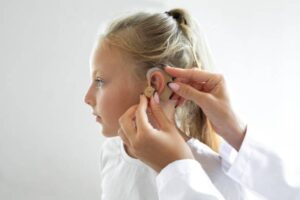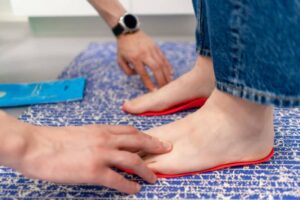Posts in Category: Health News
Hearing Aids Adelaide: Modern Hearing Aids Adelaide
As one of Adelaide’s leading hearing aid providers, we have a wealth of knowledge and experience in modern technology. We regularly review and compare the latest advancements to ensure our clients always get the best.
Our clinics also offer a range of different trial hearing aid options. It’s a great way to see whether they suit your needs and lifestyle. For more modern hearing aids Adelaide, check this out.
The Myth That “Hearing Aids Make Your Hearing Worse Over Time”
 Many people with hearing loss are eligible for government assistance through the Office of Hearing Services or the National Disability Insurance Scheme. These programs provide free hearing assessment, hearing rehabilitation, and hearing aids or assistive listening devices.
Many people with hearing loss are eligible for government assistance through the Office of Hearing Services or the National Disability Insurance Scheme. These programs provide free hearing assessment, hearing rehabilitation, and hearing aids or assistive listening devices.
Despite common misconceptions, hearing aids do not worsen your hearing over time. They simply amplify sound to improve your ability to hear. However, it will take time for your brain and ears to adjust to the new sounds and signals you encounter.
Thankfully, technological advances have allowed hearing aids to become slim and discreet. Moreover, they are available in various colour options and customisable styles, so you can find a pair of hearing aids that suit your aesthetic preferences. They are also easy to wear and can help you feel confident in the finer details of your day-to-day experiences. Lastly, most hearing clinics offer a generous satisfaction guarantee of 30 days or more to ensure you are happy with your new device.
The Myth That “Hearing Aids Are Bulky and Unattractive”
Advances in hearing aid technology have led to sleek and discreet devices that can be customised for your individual needs. They fit snugly inside your ear canal or behind the ear, and many people find them cosmetically appealing. This helps to reduce the stigma and self-consciousness often associated with wearing them. For more modern hearing aids Adelaide, check this out.
Modern hearing aids are also highly functional and include advanced features that improve your ability to communicate. This includes noise reduction, feedback cancellation, and directional microphones to help you hear better in noisy environments. In addition, wearing two hearing aids is recommended for better sound localisation and to prevent auditory deprivation in the unaided ear.
Even though hearing loss is more common as we age, it doesn’t have to be permanent. In most cases, it’s reversible and can be prevented with early intervention. Additionally, the cost of hearing aids is relatively affordable, and many insurance plans cover the expense. In addition, they provide a wide range of benefits, including improved communication and emotional well-being.
The Myth That “Hearing Aids Are Completely Invisible”
In recent years, innovative hearing aid technology development has led to sleek, discreet and cosmetically appealing designs. They are virtually invisible when worn, with many fitting inside or behind the ear canal, and come in various colour options to match your style. They also feature wireless connectivity to stream audio directly from your mobile device and offer a range of technologies that maximise sound quality, connectivity, and listening experiences.
Some hearing clinics even provide free trials and satisfaction guarantees to ensure that you are pleased with the feel and performance of your new hearing aids. All the clinics we contacted offered at least 30 days, but some went as far as 90 to give you plenty of time to try them out and see how they work for you. For more modern hearing aids Adelaide, check this out.
Additionally, if you are struggling to afford the cost of a modern hearing aid in Adelaide, remember that financial assistance is available through the Australian government’s hearing services program and the National Disability Insurance Scheme for those on low incomes.
The Myth That “Hearing Aids Are Expensive and Not Worth the Investment”
The cost of hearing aids varies and depends on the type of device chosen. However, many people are eligible for government assistance. For example, the Office of Hearing Services offers a program that provides free hearing assessment, hearing rehabilitation and hearing aids to eligible Australians. The scheme is available to all children, Indigenous Australians, most pensioners and part-pensioners, veterans and certain other groups.
In addition, the latest range of digital hearing aids is designed to be more affordable. These devices, often called ‘over-the-counter’ hearing aids, are available without a prescription or intervention from a professional and are much cheaper than traditional models.
Varicose Vein Treatment Adelaide: Affordable Varicose Vein Treatment Adelaide
Varicose veins are twisted and enlarged blood vessels that affect around 30% of Australians. They can be cosmetically unacceptable and are often a precursor to more serious medical complications.
Before 2000, surgery was the only proven treatment, but now there are alternatives. These include non-invasive procedures that don’t require general anaesthetic. For more affordable varicose vein treatment Adelaide, check this out.
Sclerotherapy
 Sclerotherapy is an excellent non-surgical treatment for varicose veins. It involves injecting a solution into the problem’s blood vessels. The injected solution irritates the lining of the blood vessel and causes it to close.
Sclerotherapy is an excellent non-surgical treatment for varicose veins. It involves injecting a solution into the problem’s blood vessels. The injected solution irritates the lining of the blood vessel and causes it to close.
Over time, the blood vessels turn into scar tissue and disappear from view. Most patients can have the procedure in their doctor’s office, which takes less than an hour. It is typically performed with other non-surgical treatments, such as ultrasound-guided phlebectomy or laser treatment.
Sclerotherapy is a safe, effective and cost-effective method of treating varicose veins. A vascular surgeon or medical practitioner will usually perform the procedure. This is done under local anaesthetic and is a minimally invasive procedure. During the process, a medical-grade irritant (sclerosant) is injected into the dysfunctional veins. The sclerosant then causes inflammation of the vein, and the blood vessels in the vein then close up.
Many different types of sclerosing agents can be used in this procedure, which will be discussed during your consultation. The most common type of sclerosant is liquid sclerotherapy, injected into the affected blood vessels using beautiful needles. Foam sclerotherapy is also an option for some patients. It involves using air or carbon dioxide mixed with standard sclerosant to form foam, which can then be injected into the abnormal blood vessels. For more affordable varicose vein treatment Adelaide, check this out.
The results of sclerotherapy for small varicose and spider veins will be visible within three to six weeks. More prominent varicose veins will take longer to respond. Some people may require multiple sclerotherapy sessions to get the desired results.
During the sclerotherapy session, a doctor will mark the affected area with ultrasound scanning to identify the blood vessels. A local anaesthetic will then be injected into the area, and the doctor will insert a needle into the vein. This is usually done with a duplex ultrasound scanner to guide the needle into the correct blood vessel.
Some patients might temporarily experience heat or heaviness in the affected area after the procedure. This is a normal reaction to the injection. Some people might also experience a feeling of tightness in the leg after the procedure. The pain is mild and will usually subside within a few days. They are wearing compression stockings to maintain pressure on the treated veins after sclerotherapy is essential.
After the procedure, most patients return to their daily routines on the same day. However, avoiding sun exposure on the legs for two weeks after the procedure is essential. This is because the inflammation of the blood vessels can cause dark spots on the skin, especially for those with darker skin tones. Covering the legs with sunscreen and wearing socks when walking outside is a good idea.
Patients should attend a follow-up appointment about a month after the treatment to ensure that all of the varicose and spider veins have responded to treatment. The physician will assess the results during these appointments and suggest more treatment sessions. For more affordable varicose vein treatment Adelaide, check this out.
Varicose Vein Treatment – What You Need to Know
Varicose veins are not only unsightly and uncomfortable but can lead to a variety of medical complications, including phlebitis (blood clots), ulcers, and other skin problems. In some cases, they can even require amputation of the legs.
If left untreated, varicose veins can become very painful and hardened, making them more challenging to manage. If you are suffering from this condition, it is best to consult Adelaide’s doctor as soon as possible for varicose vein treatment.
The type of procedure you will need will depend on the severity of your varicose veins and other factors. Some people may be able to reduce their symptoms through conservative treatments. These include diet, weight management, compression hosiery, and lifestyle changes.
Podiatrist Adelaide: Podiatry for Ingrown Toenails
Getting an ingrown toenail is painful, but it can also be dangerous. It’s important to see a podiatrist for this issue, especially for those with diabetes or poor circulation.
An ingrown treatment podiatrist Adelaide can offer a treatment plan that may include trimming the toenail, using a soaking solution, and even performing safe procedures for more serious cases.
1. Prevention
 The best way to prevent ingrown toenails is with proper foot care. It includes wearing shoes with plenty of room for the toes, keeping the feet dry and, if possible, trimming the toenails straight across using clean, sharp nail clippers without tapering or rounding the corners. It is also important to soak the feet in warm water a few times a day to help soften the nails and keep them from growing into the skin.
The best way to prevent ingrown toenails is with proper foot care. It includes wearing shoes with plenty of room for the toes, keeping the feet dry and, if possible, trimming the toenails straight across using clean, sharp nail clippers without tapering or rounding the corners. It is also important to soak the feet in warm water a few times a day to help soften the nails and keep them from growing into the skin.
A podiatrist can provide tailored treatment for ingrown toenails, from conservative measures like proper nail trimmer instruction and footwear advice to more advanced procedures performed under sterile conditions to minimize infection. For a mild ingrown toenail, the doctor may gently lift the edge of the nail and place cotton, dental floss or a splint under it. It separates the toenail from the surrounding skin and helps it grow above the skin’s edge, which usually occurs within two to 12 weeks.
For severe ingrown toenails, the podiatrist may numb your toe before removing the part of the nail that is cutting into the skin (partial nail plate excision). It reduces pain and inflammation but increases the risk of the toenail growing back deformed.
Occasionally, the doctor will remove all of your ingrown toenails (full nail plate excision). It requires a local anaesthetic and is generally performed under the supervision of an experienced physician or nurse. However, this will increase the likelihood that your toenail will come back misshapen and require repeated treatments.
Most ingrown toenails can be treated at home with warm soaks, proper nail trimming and avoiding shoes that squeeze the toes. If you have a serious case, you should see the ingrown treatment podiatrist Adelaide right away because of the potential complications and infections that can develop.
2. Diagnosis
Ingrown toenails occur when the corners or sides of a nail curve downward and dig into the skin, usually at the side of the big toe. The digging in irritates the skin and can cause pain, redness, swelling and warmth. If the toenail is infected, the area may ooze or have a foul smell. This foot condition usually develops in adults but can affect children as well. It can also be inherited.
If you suspect you have an ingrown toenail, see a doctor as soon as possible for diagnosis and treatment. It will prevent the infection from spreading through the skin around your toe and into the bone.
Your healthcare provider can diagnose an ingrown toenail by examining the toe. In some cases, your doctor may need to take a small sample of the tissue surrounding the ingrown nail. You may also need an X-ray to show how deep the ingrown toenail has grown into the skin.
Non-surgical treatments can often resolve ingrown toenails without further complications. If the ingrown toenail is not responding to home treatment, a podiatrist or other foot care specialist can remove it surgically.
Taking care of your feet is an important part of overall good health, especially for people who have diabetes or poor circulation. If you have a toenail that is painful, red or swollen, you should visit a foot care specialist as soon as possible.
3. Treatment
Ingrown toenails that have been left untreated often become infected. It can cause pain, redness, swelling, and pus around the toenail. An infected ingrown toenail should be treated right away by a foot doctor. Left untreated, the infection could spread to other parts of the body, including the bone and skin. A foot and ankle specialist can prescribe antibiotics to treat the infection if needed.
If your ingrown toenail is minor and the pain hasn’t gotten worse in a few days, home treatments may help. Soak your feet in warm water for about 15 to 20 minutes 3 or 4 times a day, using a bit of cotton or waxed dental floss to push back the edge of the nail that is digging into your skin. You can also try to trim the ingrown portion of your nail with clean toenail clippers, but only if it is safe to do so.
If home treatment doesn’t help or you have a bacterial (fungal) infection, your ingrown treatment podiatrist Adelaide, can do some surgical procedures to help. The procedure may include partial nail removal or full nail plate avulsion. In these cases, your podiatrist will numb your toe and remove the part of the nail that is digging into your skin. The rest of the nail will grow back. Your podiatrist may also use other techniques to correct the deformity of your nail if necessary.
Home-based Physio Adelaide: Home Physiotherapy Benefits For Mobility Issues and Other Health Conditions
Home-based physiotherapy sessions occur in an intimate and comfortable setting, helping reduce the stress associated with being in an unfamiliar clinical environment.
Scheduling home-based physio Adelaide sessions around daily schedules is also possible, helping reduce conflicts between sessions and other commitments. Home physiotherapy can bring many advantages for individuals with mobility challenges or other health conditions, including:
Better Adherence to Treatment Plans
Home-based physio Adelaide sessions offer individuals a safe, private and discreet setting to promote treatment adherence. Attending sessions consistently tends to lead to better rehabilitation results.
 At-home sessions allow individuals to schedule appointments around other obligations, reducing the chance of missed or cancelled appointments. It ensures they make steady progress toward their rehabilitation goals, potentially speeding up recovery and increasing quality of life.
At-home sessions allow individuals to schedule appointments around other obligations, reducing the chance of missed or cancelled appointments. It ensures they make steady progress toward their rehabilitation goals, potentially speeding up recovery and increasing quality of life.
Note that home-based physiotherapy does not provide immediate medical assistance like clinical settings do, so maintaining clear communication with therapists, having emergency protocols, and training caregivers in basic first aid are vital for ensuring a safe and successful rehabilitation experience.
Private and Confidential Environment
Home physiotherapy offers individuals a private and confidential setting to receive treatment, eliminating the risk of public sessions in clinical settings. Individuals can work with their therapist to arrange at-home sessions that fit seamlessly into their lives, helping them consistently achieve their rehabilitation goals and stay on track with rehabilitation plans. Furthermore, home physiotherapy reduces healthcare-associated infections that could hinder recovery for those recovering from paralysis.
Home-based physio Adelaide sessions offer more flexibility, and family or spouse members can often join to provide support and encouragement during treatments, making people more at ease while improving the overall quality of care and providing more hands-on rehabilitation treatment options.
Personalised Care
Home physiotherapy offers access to a relaxed environment that reduces anxiety and stress associated with clinical settings, helping individuals focus on their recovery optimistically to increase rehabilitation progress.
Home-based physiotherapy allows individuals to receive treatments when they fit their schedules, which helps prevent conflicts with other commitments and fosters consistency in rehabilitation. Furthermore, this process makes the treatment accessible to people with limited mobility by eliminating travel to a physical therapy clinic.
Convenience
Today’s instantaneous connectivity makes home-based physiotherapy ever more attractive, especially during pandemic outbreaks when patients seek alternatives to traditional clinics.
Patients experience less anxiety and stress at home in clinic settings, resulting in better adherence and greater outcomes.
Home-based sessions allow therapists to gain a fuller picture of a patient’s daily activities, giving them more information to create tailored, specific, and more effective treatments for each patient.
Therapists educate patients regularly on exercises they can do between sessions to ensure the correct execution of exercises – an integral component of rehabilitation success. Various apps and digital platforms support home rehabilitation efforts and tools that track progress or offer virtual consultations for home rehabilitation patients.
Safety
Home-based physio allows therapists to practice in an environment more familiar to clients who may feel anxious about attending clinical therapy sessions. It can also reduce stress for them.
Establishing and following appropriate emergency protocols and maintaining close communication with clients are effective strategies for mitigating risks. Therapists should also pay careful attention to sanitising and disinfecting equipment and other frequently touched surfaces in the home to reduce healthcare-associated infections in patients.
Whether you are recovering from surgery or dealing with a chronic illness, having physical therapy at home can improve your overall quality of life. While physiotherapy can be beneficial for many different conditions, it is especially useful for those who struggle with mobility issues and may have difficulty travelling to a physical therapy clinic.
Home physiotherapy is an effective treatment for patients who have trouble moving around, as well as those who have long-term mobility problems such as arthritis or cystic fibrosis. Depending on your specific needs, the physiotherapist will provide you with exercises that can help reduce pain and improve your ability to move around. These exercises can include stretches, strength training, and balance work. In addition, the physiotherapist can also recommend specific equipment that you can use in your home to assist with your recovery.
Hearing Test Adelaide: Going for a Comprehensive Check
If you’re worried about your hearing, a comprehensive hearing test Adelaide will allow you to see how severe the problem is. This article will discuss the tests that make up a comprehensive hearing evaluation.
Pure-tone testing, also known as air conduction testing, involves listening to tones through earphones and establishing the softest sounds you can hear at different pitches or frequencies, called your hearing thresholds.
Tone Test
 Pure tone audiometry is one of the most widely used and recognised hearing tests. It is a behavioural test that requires a patient to be seated in a soundproof booth with a pair of high-quality headphones. The audiologist will emit sounds at different frequencies and volumes into the patient’s ears and ask them to indicate when they can hear the sound. The audiologist can determine the extent of hearing loss by recording the softest sound that the patient can listen to, known as their threshold.
Pure tone audiometry is one of the most widely used and recognised hearing tests. It is a behavioural test that requires a patient to be seated in a soundproof booth with a pair of high-quality headphones. The audiologist will emit sounds at different frequencies and volumes into the patient’s ears and ask them to indicate when they can hear the sound. The audiologist can determine the extent of hearing loss by recording the softest sound that the patient can listen to, known as their threshold.
The audiologist will start the test with a tone well above the hearing threshold and gradually reduce it in 10 dB increments until they cannot hear it at all. It reveals the threshold for each frequency and is recorded on a chart known as an audiogram. The audiologist will also record the results for each ear individually.
Once the hearing thresholds have been recorded, the audiologist will compare them to reveal discrepancies between each ear. For example, if your right ear has a higher threshold than your left ear, you may have a symmetrical hearing loss and need hearing aids on both sides. A higher left ear threshold may indicate trouble with lower frequencies, such as men’s voices and thunder. A higher right ear threshold may indicate trouble hearing middle frequencies, such as those in conversation, or high-frequency tones, like bird songs and children’s voices.
Speech Test
The Speech Test is integral to your comprehensive hearing test Adelaide because it reveals how well you can hear two-syllable words. It helps our Green Valley audiologist determine whether you have wax or fluid buildup blocking your outer or middle ear or if you have a loss in the sensory cells of your hearing organ.
During this part of the test, you’ll sit in the sound booth and signal when you hear certain sounds by raising your hand or pushing a button. You’ll also be asked to repeat the sounds you hear so we can see how accurately you recognise them. It allows us to determine your speech reception threshold (SRT), the lowest volume of a spoken word you can understand 50 per cent of the time.
Once we have your SRT, our audiologist can compare it to the SRT of other people and use the results to create a speech audiogram. The graph shows your ability to understand speech in quiet and noisy environments.
Using a word recognition score, our audiologist may also test your ability to discriminate between speech sounds. It involves presenting a series of single-syllable words that you must repeat aloud and rating your success with them. This score is then used to rate your sensitivity to speech in noise (SIN), which is why many seek a hearing health professional.
Auditory Brainstem Response (ABR) Test
The ABR evaluation measures how well your child’s ears and the brain pathways for hearing are working. It is commonly done with infants, toddlers, or children who cannot cooperate with a standard screening test in a sound booth. It is a painless and non-invasive test.
Small electrodes are placed on your child’s head and earlobes (or on their mastoid bone). They will hear clicks through earphones. Then, the computer program will record the response to sounds and generate a waveform that can be seen on the screen.
Some studies have shown that a child’s ABR results may correlate with cognitive ability. For example, faster ABR latency has been reported for introverts versus extroverts.
Otoacoustic Emissions (OAE) Test
Otoacoustic emissions (OAE) tests evaluate the inner ear, specifically the cochlea. During this test, a probe is placed in the ear canal, and sounds are played to stimulate hair cells inside the cochlea to produce a response similar to an echo. The search then records the response. This type of comprehensive hearing test Adelaide helps diagnose if the ear has trouble detecting sound, which is often seen in certain types of hearing loss. This test is commonly used in newborn hearing screening protocols and for small children.
Physio Inq – Aged Care Physiotherapists in Woodville
Physiotherapists in Woodville can provide treatment and assessment to patients at home, hospitals, residential aged care facilities, retirement villages and nursing homes. This service is provided by www.inertiahealthgroup.com.au physio Woodville Inq Aged Care physiotherapists who can be booked at a time to suit you. You can use the search filters to refine your results and book online as soon as today or in the future.
Physiotherapy
Physiotherapy is a physical healthcare profession that promotes movement and function at all levels of the body. It involves various treatment techniques, including manual therapy, hydrotherapy, and exercise physiology. Physiotherapists work with patients of all ages and abilities, both autonomous practitioners and in collaboration with other health care professionals. Physiotherapists (physical therapists) use evidence-based knowledge of rehabilitation sciences, anatomy, kinesiology, and human physiology to treat pain, injury, movement dysfunction and chronic conditions.
 Doctors often prescribe physical therapy as part of the recovery process after surgery, injury or long-term medical conditions such as arthritis. Physiotherapists will examine your symptoms and daily activities before making a treatment plan. This may include specific exercises, massages or treatments based on physical stimuli like heat, cold, electrical currents or ultrasound. These treatments can help to improve movement, relieve pain and strengthen weakened muscles. They can also help reduce the likelihood of future problems and speed up recovery after an illness or injury.
Doctors often prescribe physical therapy as part of the recovery process after surgery, injury or long-term medical conditions such as arthritis. Physiotherapists will examine your symptoms and daily activities before making a treatment plan. This may include specific exercises, massages or treatments based on physical stimuli like heat, cold, electrical currents or ultrasound. These treatments can help to improve movement, relieve pain and strengthen weakened muscles. They can also help reduce the likelihood of future problems and speed up recovery after an illness or injury.
A physiotherapist can also advise on how to stay healthy and manage your condition. For example, they can teach you to lift objects safely or how to sit and stand in a way that minimizes your risk of getting injured. They can also help you to keep your joints flexible by showing you how to stretch or do a yoga pose.
Physiotherapy is usually covered by statutory health insurance. However, you should check with your insurer to be sure. Kaylene Killingsworth, LPT, accepts most major health insurance providers. You can verify this information on the provider’s website or by calling them. You can also schedule an appointment on their website.
Massage
Our massage therapists in www.inertiahealthgroup.com.au physio Woodville South offer a range of techniques to help you move better and feel healthier. They can provide a treatment plan to help you achieve your goals and return to doing what you love. They can treat you in a private session or a semi-private class with up to five participants. They can bulk bill if you meet specific criteria. They also accept Private Health Funds. Call for more information.
Hydrotherapy
Hydrotherapy uses water to ease pains and treat various medical conditions. It can involve baths, whirlpool tubs, and specialized pools or tanks. The temperature and flow of the water used can vary depending on the treatment goal. Many forms of hydrotherapy are simple and can be done at home. Others are more complex and require a trained provider to use. Talking to your healthcare provider before starting any new treatment, including hydrotherapy, is essential. They can tell you if the treatment has any side effects or risks.
The benefits of hydrotherapy can include a reduction in pain, stiffness, and swelling. It can also help improve mobility. It may be helpful for people with chronic diseases, such as arthritis, fibromyalgia, or multiple sclerosis. In addition, it can help prevent or reduce the severity of an injury. It can also help pregnant women reduce their risk of complications during labour and delivery.
In some cases, hydrotherapy is combined with other therapies. For example, a patient with a lower back injury might receive hydrotherapy in combination with massage or exercise therapy. This helps patients recover faster and improves overall well-being.
During an aquatic (hydrotherapy) physiotherapy class, your Back in Motion physiotherapist will guide you through group and individual water-based exercises. These classes are held at selected swimming facilities near your practice.
It’s easy to book online with a female physiotherapist in www.inertiahealthgroup.com.au physio Woodville using HotDoc. You can filter by specialty, opening hours, and availability. You can even book an appointment at a time that suits you, such as after work or on weekends. You can also find a physiotherapist who offers bulk billing.
Exercise Physiology
Exercise physiology is a science that deals with the body’s responses to physical activity. It studies the effects of long-term and short-term exercise on muscle function; cardiovascular, respiratory, and endocrine systems; energy systems, expenditure, and fatigue; resistance, aerobic, and anaerobic training; and the body’s composition. At the same time, it may seem like a field primarily interested in sports. Still, exercise physiology also covers other areas, such as using exercise to treat various conditions and diseases.




